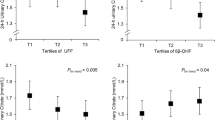Summary
The effect of enzyme induction by antipyrine, phenobarbitone and rifampicin on the time-course of urinary 6β-hydroxycortisol (6β-OHC) excretion was investigated in healthy volunteers. The drugs were given chronically for either seven or 14 days.
Significant increases in 6β-OHC excretion were observed after 4 days administration of antipyrine (1.2 g), 13 days administration of phenobarbitone (100 mg), and only 2 days administration of rifampicin (0.6 or 1.2 g). During 14 days rifampicin administration (1.2 g) 6β-OHC excretion, for individual subjects, reached a maximum on Days 11–14 when excretion was significantly greater than on day 7. On stopping rifampicin, in a 7-day study, excretion decreased over the next six days, but still remained significantly elevated compared to the original control values.
These studies show that measurement of urinary 6β-hydroxycortisol provides a simple non-invasive method with which to monitor the time-course of enzyme induction by drugs in man. However, the method cannot be used to predict clinically important drug interactions until the cytochrome P-450 enzyme responsible for cortisol 6β-hydroxylation has been fully characterized.
Similar content being viewed by others
References
Remmer H (1959) Die Beschleunigung der Evipanoxydation und der Demethylierung von Methylaminoantipyrin durch Barbiturate. Arch Exp Pathol Pharmacol 237: 296–307
Conney AH (1967) Pharmacological implications of microsomal enzyme induction. Pharmacol Rev 19: 317–365
Conney AH (1982) Induction of microsomal enzymes by foreign chemicals and carcinogenesis by polycyclic aromatic hydrocarbons. GHA Clomes Memorial Lecture. Cancer Res 42: 4875–4917
Park BK, Breckenridge AM (1981) Clinical implications of enzyme induction and enzyme inhibition. Clin Pharmacokinet 6: 1–23
Ohnhaus EE, Park BK (1979) Measurement of urinary 6β-hydroxycortisol excretion as an in vivo parameter in the clinical assessment of the microsomal enzyme-inducing capacity of antipyrine, phenobarbitone and rifampicin. Eur J Clin Pharmacol 15: 139–145
Bertilsson L, Hofer B, Tybring G, Osterloh J, Rane A (1980) Autoinduction of carbamazepine metabolism in children examined by a stable isotope technique. Clin Pharm Ther 27: 83–88
Breimer DD (1983) Interindividual variations in drug disposition. Clinical implications and methods of investigation. Clin Pharmacokinet 8: 371–377
Vesell ES (1984) Selection of subjects for investigation of host factors affecting drug response: A method to identify new pharmacogenetic conditions. Clin Pharmac Ther 35: 1–11
Park BK, Ohnhaus EE (1983) Urinary 6β-hydroxycortisol: A simple non-invasive index of enzyme induction in man. Arztl Lab 29: 53–58
Roots I, Holbe R, Hovermann W, Nigam S, Heinemeyer G, Hildebrant AG (1979) Quantitative determination by HPLC of urinary 6β-hydroxycortisol, an indicator of enzyme induction by rifampicin and antiepileptic drugs. Eur J Clin Pharmacol 16: 63–71
McPhee GJA, Thompson GG, Scobie G, Agnew E, Park BK, Murray T, McColl KEL, Brodie MJ (1984) Cimetidine inhibits carbamazepine metabolism and expression of enzyme induction in man. Br J Clin Pharmacol 18: 411–419
Vestal RE, Cusack BJ, Mercer GD, Dawson GW, Park BK (1987) Aging and Drug Interactions I. Effect of cimetidine and smoking on the oxidation of theophylline and cortisol in healthy men. J Pharm Exp Ther 241: 488–500
Park BK (1978) A direct radioimmunoassay for 6β-hydroxycortisol in human urine. J Steroid Biochem 9: 963–966
Eichelbaum M, Sonntag B, Dengler HJ (1981) HPLC determination of antipyrine metabolites. Pharmacology 23: 192–202
Gerber-Taras E, Park BK, Ohnhaus EE (1981) The estimation of 6β-hydroxycortisol in urine — a comparison of two methods: High performance liquid chromatography and radioimmunoassay. J Clin Chem Clin Biochem 19: 525–527
Sanghvi A, Wight C, Parikh B, Desal H (1973) Urinary 17-hydroxycorticosteroid determination with p-hydrazino-sulfonicphosphoric acid. Am J Clin Pathol 60: 684–690
Park BK, Ohnhaus EE (1983) Urinary 6β-hydroxycortisol: a simple non-invasive index of enzyme induction in man. Arztl Lab 29: 53–58
Pal SB (1978) 6-Hydroxylation of cortisol and urinary 6β-hydroxycortisol. Metabolism 27: 1003–1011
Park BK (1981) Assessment of urinary 6β-hydroxycortisol as an in vitro index of mixed-function oxygenase activity. Br J Clin Pharmacol 12: 97–102
Berlin CM, Schimke RT (1965) Influence of turnover rates on the responses of enzymes to cortisone. Mol Pharmacol 1: 149–156
Levy RH, Lai AA, Dumain MS (1979) Time-dependent kinetics IV: Pharmacokinetic theory of enzyme induction. J Pharm Sci 68: 398–399
Lai AA, Levy RH, Cutler RE (1978) Time-course of interaction between carbamazepine and clonazepam in normal man. Clin Pharm Ther 24: 316–323
Author information
Authors and Affiliations
Additional information
Dedication. Causes of the variability of drug response has been a continuing preoccupation of pharmacologists for many years. Over the last twelve years, the authors of this paper have collaborated in many studies on various facets of this subject, most concerned with the problems of microsomal enzyme induction.
Edgar Ohnhaus, the first author, died in January 1988. This paper aims to put in context important new data with those produced in other studies and which the authors have published together. It is presented as a scientific tribute to a skilled and tenacious clinical pharmacologist who is sadly missed
Rights and permissions
About this article
Cite this article
Ohnhaus, E.E., Breckenridge, A.M. & Park, B.K. Urinary excretion of 6β-hydroxycortisol and the time course measurement of enzyme induction in man. Eur J Clin Pharmacol 36, 39–46 (1989). https://doi.org/10.1007/BF00561021
Received:
Accepted:
Issue Date:
DOI: https://doi.org/10.1007/BF00561021




